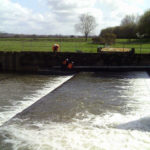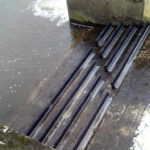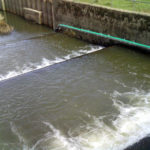New fish & eel passes help more species to migrate upstream
According to the Sussex Wildlife Trust, eel stocks have fallen by over 90% in line with a global trend, and the Environment Agency is coordinating a number of measures to help in the recovery of the species. Part of the programme involves the installation of fish and eel passes on river structures such as weirs and sluices which can restrict their migratory path and ECS Engineering Services has recently been involved in the installation work at Hardham Weir in West Sussex.
At the point where the River Rother meets the River Arun, near Pulburough, West Sussex, lies Hardham Weir, which is considered to be amongst one of the top 30 obstructions to fish passage in the South of England. This project was designed to remove or by-pass the concrete weirs in the main river and restore the wetland habitat, allowing fish to travel up-stream to spawn and improve fish and eel populations in the upper Arun.
Improving water quality in British rivers has seen fish populations and diversity on the increase, but the population of eels has seen a drastic fall over recent years and it continues to decline. The exact reasons for this massive drop in numbers are unknown, but efforts are underway across Europe to try and address the issue. In Sussex, eel fishing has been banned for several years and plans are being implemented to both monitor the population and to pro-actively help it recover.
The Environment Agency is helping to improve the available data on the eel population and its migration patterns by installing eel and elver passes at a number of weirs and sluices across the country. These serve two main purposes; to ease the passage of the eels along the course of a river and, with the addition of an eel trap, to collect accurate data on the eel population.
Under EU Council Regulation (EC) No. 1100/2007, Article 9 requires member states to evaluate the effectiveness of Eel Management Plans and to report to the European Commission every three years with their best estimates on silver eel migration figures. One of the more efficient methods of obtaining this information is through the use of eel traps positioned within eel passes that are installed to assist the eels in bypassing large river structures, such as weirs and sluices.
The project at Hardham weir involved the design and installation of a fish pass on a section of the weir and an eel / elver pass which was attached to the wall of the weir. The design of the fish pass resembles a ladder which has a gap in each ‘rung’, offset from the one below. This is designed to allow the fish an area to rest before negotiating the next ‘rung’ of the ladder and progressing up the weir.
The ladder comprises four ‘rungs’ made from KLP recycled plastic and secured to the concrete with steel supports. These were installed after a large number of sandbags were used to isolate the required section of the weir and divert the flow to an adjacent section. The design of the fish pass has been monitored by the EA for its effectiveness on a number of sites and so far is proving to be very successful.
The eel and elver pass was a slightly more difficult installation, requiring much of the work to be carried out from a small boat. The design uses a number of aluminium sections which contain plastic brushes with a bristle density that is optimised for the eels and elvers to allow them to propel themselves along the channel. Water is fed in at the highest point of the channel from where it flows to the lowest point, attracting the eels and elvers to the entrance of the channel section. The eel pass also includes the facility to capture all of the eels using the pass over a set period, allowing the Environment Agency to provide much needed information on this species.
Phil Anderson, Project Manager at ECS, comments: “The Environment Agency is looking to improve the number of species in England’s inland waterways and improve the habitats for migratory species as well. We have worked with the EA for many years, successfully installing many projects including those such as this, where additional safety precautions are required due to the deep water hazard. Projects such as this are important to people as well as the animals and they help to deliver the requirements of the Water Framework Directive.”
- The project at Hardham weir involved the design and installation of a fish pass on a section of the weir and an eel / elver pass which was attached to the wall of the weir
- The fish pass is designed to allow the fish an area to rest before negotiating the next ‘rung’ of the ladder and progressing up the weir
- The design of the eel pass uses a number of aluminium sections which contain plastic brushes with a bristle density that is optimised for the eels and elvers to allow them to propel themselves along the channel








